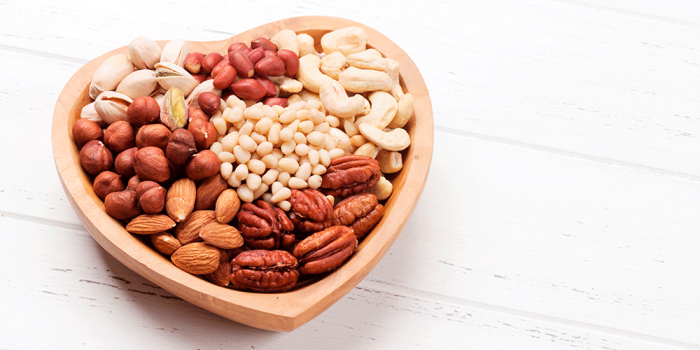Nuts are a food group that includes almonds, Brazil nuts, cashews, hazelnuts, macadamias, pecans, pine nuts, pistachios, peanuts and walnuts. Due to their particular high content in fats and low water content, this food group has been unfairly and widely linked to weight gain. However, as we will see, not only are they not related to weight gain; they may also prevent us against it.
When eaten as part of a healthy balanced diet, nut consumption does not promote weight gain (while eating the recommended portions) due to a number of factors[1]:
- Their caloric content does not coincide with the usable caloric content/metabolizable energy. In other words, what we eat is not equal to what we absorb. In between, there are a series of events, such as digestion itself, that can be more complex when faced with these foods. Therefore, the calorie content of the labels can overestimate the real content that we end up taking advantage of.
- Due to their complex matrix where fiber, protein and fat are combined, they may help regulate appetite.
- These foods may slightly elevate thermogenesis (the process of heat production in organisms).
- They can also favorably modulate the gut microbiota through their high content in fiber, fatty acids and polyphenols.
Last but not least, nuts act indirectly by removing the ultra-processed foods from your diet. A handful of nuts will always be better than eating an ultra-processed snack.
So, What Are 5 Reasons to Consume or Continuing to Consume Nuts?
- Nuts are associated with better cardiovascular health due to their content in arginine, magnesium, selenium, polyphenols, and unsaturated fatty acid profile[2].
- Nuts may help improve glycemic control, blood pressure and blood lipids (cholesterol levels), therefore they are recommended for diabetes, obesity or metabolic syndrome[2].
- Nuts may help you maintain body weight through the mechanisms described above[1].
- If your goal is to lose body fat and you have a well-planned diet to help you meet this goal, the inclusion of nuts does not hinder the process. In fact, it may even help you[3].
- Nuts add a wide variety of flavors and textures to your dishes and to your diet. They are versatile and generally go really well with other ingredients / foods.
How to Include Nuts into Your Diet?
In point 5 I mentioned that one of the main advantages of nuts was their versatility. See the table below to discover examples of how to combine nuts with other ingredients:
| Nuts for Breakfast | Nuts in Meals | Nuts as a Snack | Nut Creams | Nuts in Milkshakes or Porridge |
|---|---|---|---|---|
| With dairy products (or alternatives) and fruit. | As an ingredient in salads. They add a distinctive touch to the dish. | It’s normal to snack in between hours. If you do so, snacking on nuts is a great option. | Nut creams are trendy. However, we should prioritize the whole nuts (and raw, if possible). | With dairy products or dairy alternatives (milk, vegetable drinks or yogurt), oats and fruit. |
What Counts as a Portion of Nuts?
A serving of nuts can be established around 30 g / 1 oz (a handful) already peeled. It is important that you do not consume them directly from the bag to avoid overdoing it. Try rationing them previously by creating individual portions.
To find out more about Carlos Rios check out his Instagram @carlosriosq.
[1] Tindall, A. M., Petersen, K. S., Lamendella, R., Shearer, G. C., Murray-Kolb, L. E., Proctor, D. N., & Kris-Etherton, P. M. (2018). Tree Nut Consumption and Adipose Tissue Mass: Mechanisms of Action. Current developments in nutrition, 2(11), nzy069. https://doi.org/10.1093/cdn/nzy069
[2] Kim, Y., Keogh, J. B., & Clifton, P. M. (2019). Does nut consumption reduce mortality and/or risk of cardiometabolic disease? An updated review based on meta-analyses. In International Journal of Environmental Research and Public Health (Vol. 16, Issue 24). MDPI AG. https://doi.org/10.3390/ijerph16244957
[3] Akhlaghi, M., Ghobadi, S., Zare, M., & Foshati, S. (2020). Effect of nuts on energy intake, hunger, and fullness, a systematic review and meta-analysis of randomized clinical trials. In Critical Reviews in Food Science and Nutrition (Vol. 60, Issue 1, pp. 84–93). Taylor and Francis Inc. https://doi.org/10.1080/10408398.2018.1514486










